So many things that characterize our time in Kathmandu already happened in the first hour in Nepal. At the arrival you have to pay 40 US$ for the visa. When I put the money on the desk, one official took it away and then an other one asked me to pay the fees. I told him firmly that his colleague already had taken the money, which he first denies before – by miracle – remembering he had put the 40 US$ in his pocket …. welcome to Nepal!
Out of the airport, we were soon surrounded by taxi driving touts, who wanted to bring us for a huge amount of money to a hotel of their choice. We got so annoyed that we decided to look for a public bus instead, and indeed, one person explained us where to go. Entering the bus, all the locals looked at us extremely surprised, obviously wondering whether we were on the wrong bus or whether they were. But anyway, they kindly offered us their help to find our way to Thapatali.
Everyone knowing Kathmandu may now be attempted to ask “Thapatali? I thought the name is Thamel?”. Exactly that was the reaction of all the taxi drivers and their enthusiasm faded remarkably when realizing that we do not want to go to the tourist-ghetto of Thamel. Yes, we were going to Thapatali, because there we met Tamara, Steve’s former fellow student in Mannheim, who is currently doing an internship at the GIZ, the German organization for development aid. And luckily we had the chance to stay at their guest-house, because this Kathmandu upper-class district was much more original than Thamel’s “Europe Town”.
While walking on the river side to the guest-house, we soon noted that we were neither in China nor in South-America: despite being holy, the “Bagmati River” serves as landfill and sewer, spreading its ugly smell all over the capital. Worse, there are people living not next to tons of rubbish, but literally inside. South-America often was dirty, Nepal is bathing in waste. After seeing how respectful Nepalis treat their holy waters, we got curious and wanted to see the situation at the most important temples. To put it short: not any better. We headed to Pashupatinath, also called “Little Varanasi”, where the cremation ceremonies of the Hindus are held. Obviously, they consider these farewells as a spectacle and therefore they demand an entrance fee of 10 € for it (the good news: they did not sell any popcorn). Until today we do not know whether they really have an official fee, or whether it was a trick from some clever businessman supported by corrupt policemen. Nevertheless, we sponsored the good old local corruption-traditions and bargained a “student discount” to get in.
Honestly, watching at the ceremonies was a strange, but good experience. First, it was uncommon and disturbing for us to see a dead body burning. After a while and some reflection we appreciated the mourning rituals. You can almost feel how the soul vanishes and flies away, for the relatives it was apparently a very intense and concrete moment to say goodbye. We also learned a lot about the rituals following the cremation, which can last up to one year. Probably this structure facilitates dealing with the dead of a beloved person and is lacking a bit in Europe. On the other hand, the separation between the classes remains, only the rich ones can afford a ceremony there, and only the very rich ones can burn their relatives at the right-hand side of the bridge. Anyway, we had a lot to think about and almost forgot that the river was dirty and that they sell tickets for this event.
In Kathmandu, we had to apply for our Indian visa, which is a cumbersome process. You have to go three times to the embassy (understandable, when you know that millions of European working immigrants want to invade the Promised Land of India) and wait up to 6 hours there. Common curses are too weak to describe it, that’s why wisely we had made provisions and were able to make some stronger statements. The day before, we were in Thamel for laundry service and went to a Tibetan restaurant afterwards. We were late and the only guests, they wanted to close and we ordered steamed water-buffalo MoMos. The resulting food poisoning was the worst in my life after the legendary paella in Chambourcy and allowed us to vomit several times in the embassy’s garden. Once again, we realized that the rule of thumb holds: preferably go to the places where the locals eat every day, even when they look poorer than in the tourist hotspots.
Of course, we visited lots of nice stupas and temples. The huge Boudhanath, the monkey invaded Swayambunath, the crowded Durbar Squares of Kathmandu and Patan, the Kirtipur neighborhood and charming Bakthapur’s medieval center. Sometimes the entrance fees are fair, sometimes they’re not, and in the latter case it is easy to circumvent the main gate and find a prettier and cheaper way through the small streets. In comparison to China, those Buddhist and Hindu religious sites are more important in everyday life. Believers clearly know what their faith is about, and compared with Christianity the practice is more concrete. It is fixed what brings good luck and what brings bad luck. However, it is not just symbolic. On every Durbar Square, there is a young girl, the Kumari, who is regarded as a god until her first menstruation. To choose her, they let her sleep in a room with dead animals. If she is not frightened, she is recognized as a living incarnation. In Europe, we may also believe in metaphysical entities, but what you can see on earth is rather seen as a symbol pointing to something in another realm. For us as enlightened persons, it is impossible to imagine that someone used to be a god before losing this skill again, no matter how hard we try. In Nepal such thoughts are normal part of religious practice.
We also saw that Nepal is a poor and underdeveloped country. In fact, it’s the poorest country in the region (yep, behind Bangladesh). For 1€ you get a haircut, a shave and an additional massage, On the other hand, you have half a day load-shedding in Kathmandu, when the city falls into a state of medieval darkness. Now, candlelight has lost all its romantic appeal to us. Surely, you are eager to hear about food. When Malaysian food is a multi-volumed encyclopedia, Nepali food can be regarded as an SMS. Actually, it consists only of “Dal-Bhat”, which is made of rice, lenses and vegetables. It is quite tasty but a bit monotone in the long run. That’s why, for the first time since South-America, we have not only eaten local food. For example, we went to the Hot-Pot Restaurant, ate a mix of Chinese, Western and Indian food and talked very long with the owner.
In general, our experiences with the Nepalis in Kathmandu were extremely mixed. It was the first time you always have to be aware that they may cheat you. Before, you had to be careful, here it is necessary to be suspicious. This really is a pity because you miss good experiences and hurt people who have not deserved it. On the other hand, we also have a lots of nice stories to tell, just like they happened in our other countries as well. So our impressions are very contradictory: There are people politely showing you the way and extremely annoying touts. In Bakthapur hundreds of school kids wanted to shake hands with us and spoke English fluently, near Swayambunath middle class kids begged us for Rupees. We experienced the annoying bargaining with the taxi drivers and the nice people on the bus. You have the vendors who are friendly in order to cheat you easier and waiters in low-price restaurants who come out to stop the right bus for you. We met Tej, the caretaker in the GIZ guest-house, who is so helpful and ready to arrange everything we need, and travel agency advisers who try to charge not less than the tenfold of the normal bus price. At one occasion a super polite policeman kindly asked us to leave an area near an important monument, apologized for the inconvenience and started asking us where we are from and what plans we have. At another occasion the man at the ticket counter was so rude and lazy that he did not even want to sell anything!
Now, if you are confused by this blog entry, well, then we guess we have described Kathmandu in an appropriate way ….
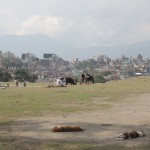
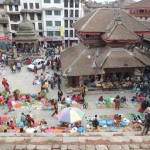
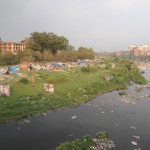
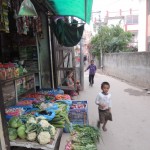
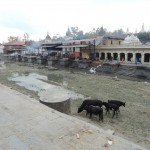
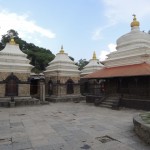
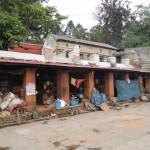
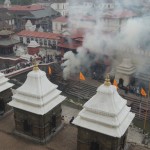
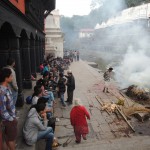
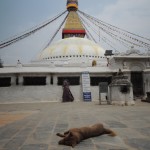
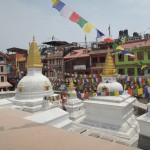
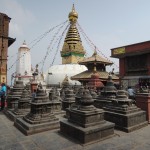
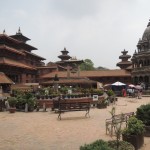
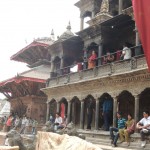
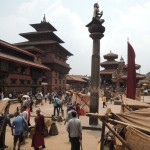
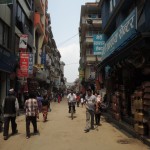

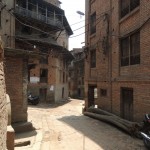
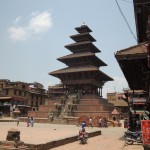
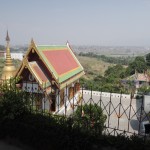

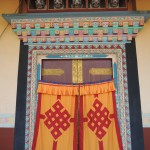
La Paella de Chambourcy… Quelque Chose qu’on n’oubliera pas !
Kann ich alles auch so bestätigen, normalerweise essen wir nur “inländisch”, in Nepal gabs jedoch auch chinesisch, italienisch, koreanisch, deutsch!!!!!!
In Pashupatinah haben wir beim 2. Mal den Weg hintenrum gefunden:-)
Dieses Jonglieren zwischen Vertrauen und Misstrauen hat uns auch genervt.
Gruß Thea
C’est la première fois dans tes articles, et ceci malgré vos efforts pour ne pas regarder à priori chaque personne comme quelqu’un qui veut vous arnaquer, que j’ai l’impression que cet endroit ne vous a pas plu. Mais peut-être est-ce aussi une bonne préparation à ce que vous pourrez peut-être rencontrer de semblable en d’autres lieux en poursuivant votre voyage … …
Nous étions à Kathmandou en 1987 je trouve que ça n’apas beaucoup changé:la saleté, les temples, les marchés, les rues et surtout comme tu le décris bien on n’a pas la paix sans arrêt sollicités ça donne envie de s’enfuir!!!; j’en suis étonnée; je m’attendais à un peu plus de modernisme pour cette capitale;Mais c’est comme à Madagascar, le régime politique et la corruption ne favorise pas l’essor d’un pays
J’espère que voues irez vous aérer dans les montagnes